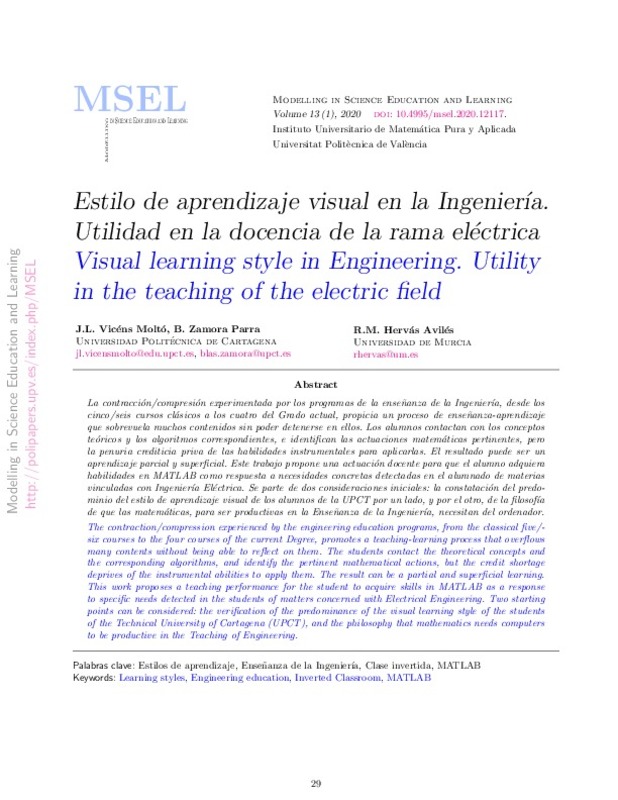JavaScript is disabled for your browser. Some features of this site may not work without it.
Buscar en RiuNet
Listar
Mi cuenta
Estadísticas
Ayuda RiuNet
Admin. UPV
Estilo de aprendizaje visual en la Ingeniería. Utilidad en la docencia de la rama eléctrica
Mostrar el registro sencillo del ítem
Ficheros en el ítem
| dc.contributor.author | Vicéns Moltó, J.L.
|
es_ES |
| dc.contributor.author | Zamora Parra, Blas
|
es_ES |
| dc.contributor.author | Hervás, R.M.
|
es_ES |
| dc.date.accessioned | 2020-03-06T11:01:12Z | |
| dc.date.available | 2020-03-06T11:01:12Z | |
| dc.date.issued | 2020-01-28 | |
| dc.identifier.uri | http://hdl.handle.net/10251/138447 | |
| dc.description.abstract | [ES] La contracci´on/compresi´on experimentada por los programas de la ense˜nanza de la Ingenier´ıa, desde los cinco/seis cursos cl´asicos a los cuatro del Grado actual, propicia un proceso de ense˜nanza-aprendizaje que sobrevuela muchos contenidos sin poder detenerse en ellos. Los alumnos contactan con los conceptos te´oricos y los algoritmos correspondientes, e identifican las actuaciones matem´aticas pertinentes, pero la penuria crediticia priva de las habilidades instrumentales para aplicarlas. El resultado puede ser un aprendizaje parcial y superficial. Este trabajo propone una actuaci´on docente para que el alumno adquiera habilidades en MATLAB como respuesta a necesidades concretas detectadas en el alumnado de materias vinculadas con Ingenier´ıa El´ectrica. Se parte de dos consideraciones iniciales: la constataci´on del predominio del estilo de aprendizaje visual de los alumnos de la UPCT por un lado, y por el otro, de la filosof´ıa de que las matem´aticas, para ser productivas en la Ense˜nanza de la Ingenier´ıa, necesitan del ordenador. | es_ES |
| dc.description.abstract | [EN] The contraction/compression experienced by the engineering education programs, from the classical five/-six courses to the four courses of the current Degree, promotes a teaching-learning process that overflows many contents without being able to reflect on them. The students contact the theoretical concepts and the corresponding algorithms, and identify the pertinent mathematical actions, but the credit shortage deprives of the instrumental abilities to apply them. The result can be a partial and superficial learning. This work proposes a teaching performance for the student to acquire skills in MATLAB as a response to specific needs detected in the students of matters concerned with Electrical Engineering. Two starting points can be considered: the verification of the predominance of the visual learning style of the studentsof the Technical University of Cartagena (UPCT), and the philosophy that mathematics needs computersto be productive in the Teaching of Engineering. | es_ES |
| dc.language | Español | es_ES |
| dc.publisher | Universitat Politècnica de València | es_ES |
| dc.relation.ispartof | Modelling in Science Education and Learning | es_ES |
| dc.rights | Reconocimiento - No comercial (by-nc) | es_ES |
| dc.subject | Learning styles | es_ES |
| dc.subject | Engineering education | es_ES |
| dc.subject | Inverted Classroom | es_ES |
| dc.subject | MATLAB | es_ES |
| dc.subject | Estilos de aprendizaje | es_ES |
| dc.subject | Enseñanza de la Ingeniería | es_ES |
| dc.subject | Clase invertida | es_ES |
| dc.title | Estilo de aprendizaje visual en la Ingeniería. Utilidad en la docencia de la rama eléctrica | es_ES |
| dc.title.alternative | Visual learning style in Engineering. Utility in the teaching of the electric field | es_ES |
| dc.type | Artículo | es_ES |
| dc.identifier.doi | 10.4995/msel.2020.12117 | |
| dc.rights.accessRights | Abierto | es_ES |
| dc.description.bibliographicCitation | Vicéns Moltó, J.; Zamora Parra, B.; Hervás, R. (2020). Estilo de aprendizaje visual en la Ingeniería. Utilidad en la docencia de la rama eléctrica. Modelling in Science Education and Learning. 13(1):29-36. https://doi.org/10.4995/msel.2020.12117 | es_ES |
| dc.description.accrualMethod | OJS | es_ES |
| dc.relation.publisherversion | https://doi.org/10.4995/msel.2020.12117 | es_ES |
| dc.description.upvformatpinicio | 29 | es_ES |
| dc.description.upvformatpfin | 36 | es_ES |
| dc.type.version | info:eu-repo/semantics/publishedVersion | es_ES |
| dc.description.volume | 13 | es_ES |
| dc.description.issue | 1 | es_ES |
| dc.identifier.eissn | 1988-3145 | |
| dc.relation.pasarela | OJS\12117 | es_ES |
| dc.description.references | Chapra, Steven C. (2018) Applied numerical methods with MATLAB for engineers and scientists. McGraw-Hill Education, New York. 715 pp. | es_ES |
| dc.description.references | Felder, R. M., Soloman, B. A., Index of Learning Styles Questionnaire. https://www.webtools.ncsu.edu/learningstyles/ | es_ES |
| dc.description.references | Felder, R. M., Silverman, L. (1988). Learning and Teaching Styles in Engineering Education. Journal of Engineering Education, 78(7), 674-681. | es_ES |
| dc.description.references | Hoffman, J., Johnson, C., Logg, A. (2004). Dreams of Calculus. Perspectives on Mathematics Educa-tion. http://www.bodysoulmath.org/books/dreams-of-calculus.pdf https://doi.org/10.1007/978-3-642-18586-1 | es_ES |
| dc.description.references | Stewart, J. ( 2016 ). Calculus, Eighth Edition. CengageLearning, Boston. 1545 pp. | es_ES |
| dc.description.references | Vicéns J. L. (2012). Una modalidad de tutor-facilitador en la enseñanza de la ingeniería, en Gaviria, J. L., Palmero M. C., Alonso, P. (Eds.). Entre generaciones: Educación, herencia y promesas. Actas del XV Congreso Nacional y V Iberoamericano de Pedagogía. Ed. ICCE, Madrid, 440-449. | es_ES |
| dc.description.references | Vicéns J.L., Zamora, B., Hervás, M. R. (2018a). Una aplicación de los estilos de aprendizaje en la Universidad Politécnica de Cartagena, en Miralles, P., Guerrero, C. (Eds.). Metodologías docentes innovadoras en la enseñanza universitaria. Editum. Murcia, 403-415. | es_ES |
| dc.description.references | Vicéns J.L., Zamora, B., Hervás, M. R. (2018b). Un Análisis de las actitudes visuales y verbales de alumnos noveles de Grado de Ingeniería en la Universidad Politécnica de Cartagena. Libro de Ac-tas del XXVI Congreso Universitario de Innovación Educativa en las Enseñanzas Técnicas. Escuela Politécnica de Ingeniería de Gijón, 621-632. | es_ES |








